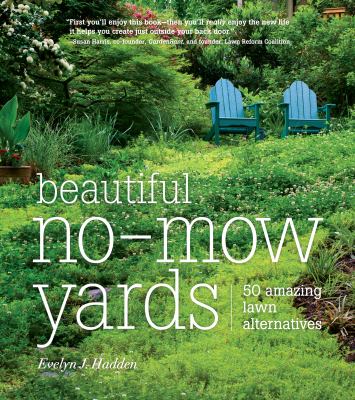Redefining Your Lawn
By George Graine, Fairfax Master Gardeners
“What has your perfect lawn done for you lately? Is it really worth the time, effort and resources you lavish on it?” —Evelyn J. Hadden
 As some politicians say these days, “Let me be clear.” I do not have a dog in the fight of no-mow yards. Nor do I dispel the evolving Cooperative Extension encouragement for turf nutrient management programs. Evelyn J. Hadden wrote, “Lawns care is familiar to many of us — some of us have done it all of our lives — but we have no clue how to care for other types of landscape. It is always harder to do something new than to respect what you have done a zillion times before. But as you continue to respect that unfamiliar chore, it gets easier.” Hadden wrote a definitive book on how to redefine your lawn called “Beautiful No-Mow Yards: 50 Amazing Lawn Alternatives” (Timber Press, 2012). If you want to consider many creative approaches to no-mow yards, this book together with almost 300 muted color photos, attests to how you can decrease your monoculture — the lawn. As the author writes, “… you won’t need to keep trimming that lawn if you trim it out of your budget.” Perhaps an area should be preserved for a lawn, although perfection is not necessarily the goal. A place to play, for entertaining, even lying down to look up at the stars or anything else in your lifestyle might be just enough lawn.
As some politicians say these days, “Let me be clear.” I do not have a dog in the fight of no-mow yards. Nor do I dispel the evolving Cooperative Extension encouragement for turf nutrient management programs. Evelyn J. Hadden wrote, “Lawns care is familiar to many of us — some of us have done it all of our lives — but we have no clue how to care for other types of landscape. It is always harder to do something new than to respect what you have done a zillion times before. But as you continue to respect that unfamiliar chore, it gets easier.” Hadden wrote a definitive book on how to redefine your lawn called “Beautiful No-Mow Yards: 50 Amazing Lawn Alternatives” (Timber Press, 2012). If you want to consider many creative approaches to no-mow yards, this book together with almost 300 muted color photos, attests to how you can decrease your monoculture — the lawn. As the author writes, “… you won’t need to keep trimming that lawn if you trim it out of your budget.” Perhaps an area should be preserved for a lawn, although perfection is not necessarily the goal. A place to play, for entertaining, even lying down to look up at the stars or anything else in your lifestyle might be just enough lawn.
“Beautiful No-Mow Yards” is not a handbook. Each of the gardens in this book was chosen to highlight specific ideas and strategies. Look at these gardens as starting points because you have an opportunity to personalize your space and, of course, be mindful of the gardener’s mantra — right place, right plant in addition to right purpose. Consider hardiness and heat zones, size, texture, color, noticeable season change and anything else that may be important to you. Also note the oft-used expression — my garden is a work in progress. This should not be an embarrassment or an excuse. Rather the no-mow yard is a happening. As a garden evolves, you will be rewarded by a desire to make changes in emphasis or try the newest plant du jour. The key point is to love your new space because you probably only tolerated your lawn.
Lawn alternatives are not a new phenomenon. They have always been available but used in more limited ways, such as island beds and mixed borders. Does the expression “familiarity breeds contempt” come to mind when considering the lawn? Perhaps not, but be honest — what happens when you have a cranky lawn mower or the blade shreds your grass? Maybe you feel compelled to interrupt your alternate weekend plans in order to manicure the lawn. Why must a lawn be so oppressive? Is the grass greener on the other side of the fence? Do you really care? Do you aspire to have the neighborhood lawn of the week? Does any of this make sense? Think about these questions before you decide that it would really be nice to have free time for other pursuits and what’s not to like about saving more than a few bucks.
If you agree that your lawn is nothing more than a green carpet, nice to look at but seldom used, like a formal dining room, then “Beautiful No-Mow Yards” can take you through the steps to wean yourself away from cookie-cutter yards with typical foundation plantings. Think plant diversity and at the same time carefully consider working with nature. This means understanding plant selection in order to minimize maintenance. You are the overseer of your landscape. How you spend your time will depend on three things including your site, your design and your own standards. Of course, any garden budget should be reconciled along with all of your other expenses.
“Beautiful No-Mow Yards” is divided into three parts. The first section, “Design Inspiration: The Many Possibilities,” showcases many different real life opportunities for lawnless gardens. The next section is all about the importance of “How to Get There,” that is, how to convert an existing lawn into your garden of choice. The final section, “Choice Ground-Layer Plants,” features a sampling with explanations of commonly available plants (1 inch to 4 feet) that can often be found at full service garden centers. Are you convinced? Is a no-mow yard in your future? Gardening is not rocket science. In fact, with the right attitude and motivation, gardening is shockingly simple and provides hours of pleasure when working outside and observing your new oasis.